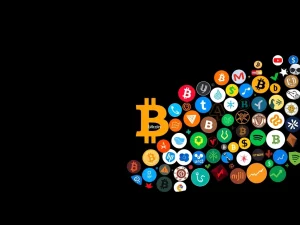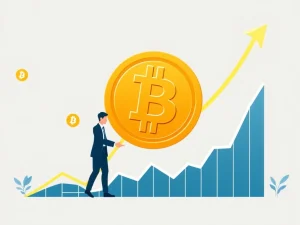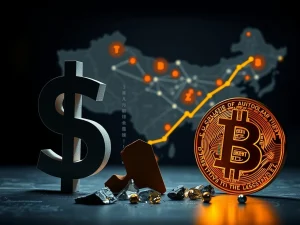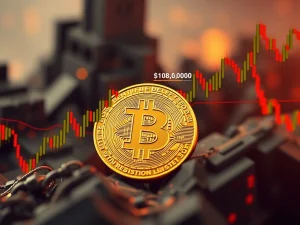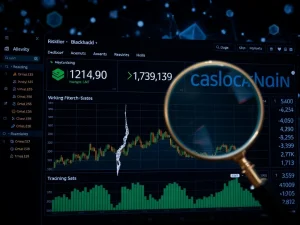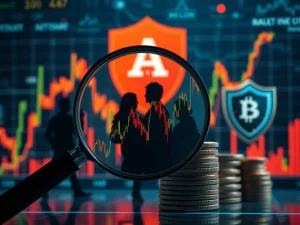Bitcoin ETFs: Kiyosaki’s Crucial Warning Amid Divergent Gold & Ethereum Inflows
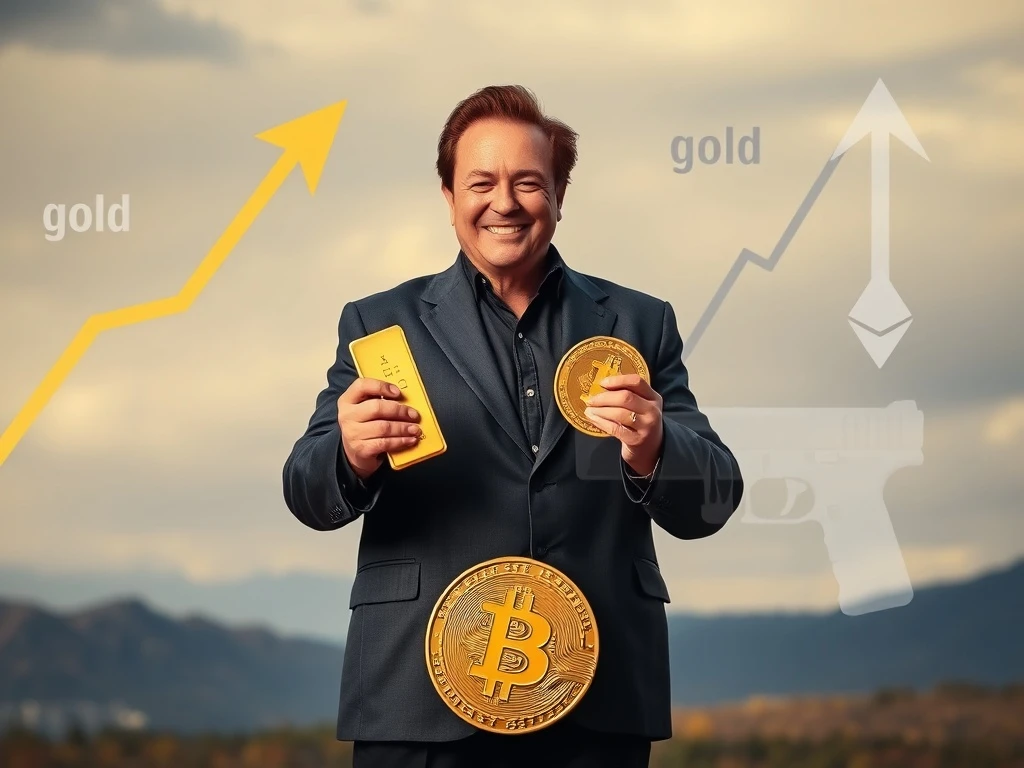
In the dynamic world of cryptocurrency, where market sentiments can shift at lightning speed, a prominent voice has once again stirred the pot. Robert Kiyosaki, the best-selling author of “Rich Dad Poor Dad,” has issued a compelling warning against the growing reliance on Exchange-Traded Funds (ETFs), particularly in the context of digital assets. This caution comes at a pivotal moment, as we witness a fascinating paradox in the market: significant inflows into gold and Ethereum ETFs, while Bitcoin ETFs surprisingly face outflows. What does this divergence mean for your crypto investing strategy, and should Kiyosaki’s advice reshape your approach?
Robert Kiyosaki’s Urgent Warning: Why Physical Assets Trump ETFs
Robert Kiyosaki has long been a vocal advocate for direct ownership of tangible assets, a philosophy he consistently champions across his platforms. In a recent post on X, he likened ETFs to “a picture of a gun for personal defense,” powerfully illustrating his belief that convenience offered by these financial instruments cannot replace the tangible security and control of holding physical assets. For Kiyosaki, this includes not just precious metals like gold and silver, but also Bitcoin itself. His argument centers on the idea that while ETFs offer exposure, they lack the intrinsic value and direct control that comes with true ownership, potentially exposing investors to systemic risks inherent in paper assets.
This perspective is particularly relevant now, as investors navigate a complex macroeconomic landscape marked by:
- Rising inflation concerns
- Geopolitical tensions
- Unpredictable central bank policies
Kiyosaki’s stance challenges the conventional wisdom of modern portfolio theory, urging individuals to prioritize resilience and independence in their financial holdings. His warnings resonate deeply with those seeking alternatives to traditional financial systems and fiat currencies, which he views as increasingly vulnerable to devaluation and manipulation.
Gold ETFs Shine Bright: A Haven in Turbulent Times?
While Bitcoin ETFs experienced a reversal, physically backed Gold ETFs have been on an undeniable surge, signaling a robust investor appetite for the traditional safe-haven asset. The first half of 2025 saw global physically backed gold ETFs record an astonishing $38 billion in net inflows. This marks their strongest semi-annual performance since 2020, underscoring gold’s enduring appeal amidst global uncertainties.
The inflows were widespread, with significant contributions from various regions:
- North America: Led the charge with $21 billion in inflows, marking their best first-half performance in five years.
- Asia: Added a substantial $11 billion to the total.
- Europe: Contributed $6 billion, effectively ending a streak of losses that had persisted since late 2022.
Total assets under management (AUM) for gold ETFs soared by 41% year-to-date, reaching an impressive $383 billion. Holdings climbed by 397 metric tons to 3,616 tons, hitting their highest level since August 2022. This rally highlights gold’s reinforced role as a hedge against inflation and geopolitical instability, solidifying its appeal for investors seeking stability and capital preservation.
Bitcoin ETFs Face Headwinds: What’s Driving Recent Outflows?
In stark contrast to gold’s stellar performance, Bitcoin ETFs recently broke a 12-day streak of inflows, recording $131.35 million in net outflows on June 24. This shift indicates a growing investor caution and a re-evaluation of Bitcoin’s immediate market position. Several major players in the Bitcoin ETF space experienced significant withdrawals:
- Ark & 21Shares’ ARKB: Suffered the largest single-day withdrawal at $77.46 million.
- Grayscale (GBTC): Also reported outflows, continuing a trend of redemption pressures.
- Fidelity (FBTC): Saw outflows, indicating broader market sentiment.
This reversal underscores the volatility inherent in the crypto market and the impact of macroeconomic uncertainty on investor confidence. Factors such as ongoing regulatory scrutiny, fluctuating interest rate expectations, and broader risk-off sentiment in traditional markets likely contributed to this cooling of interest in Bitcoin ETFs. While Bitcoin remains a cornerstone of the digital asset space, its recent performance in the ETF sector suggests a period of consolidation and reassessment by institutional and retail investors alike.
Ethereum ETFs Gain Momentum: A Glimmer of Hope for Digital Assets?
Amidst the contrasting narratives of gold and Bitcoin, Ethereum ETFs have emerged as a beacon of positive momentum in the digital asset space. On the same day Bitcoin ETFs faced outflows, Ethereum ETFs logged an impressive $296.6 million in net inflows, extending their positive streak. This strong performance signals renewed institutional and retail interest in Ethereum, driven by several key factors:
- Fidelity’s FETH fund: Attracted a significant $126.93 million.
- BlackRock’s ETHA: Added $102 million, demonstrating strong institutional conviction.
Ethereum’s 12-day consecutive inflow streak reflects optimism surrounding the ongoing upgrades to the Ethereum blockchain, particularly its transition to a more energy-efficient proof-of-stake mechanism and its growing utility in decentralized finance (DeFi) and NFTs. Investors appear to be recognizing Ethereum’s potential as a foundational technology for the broader crypto ecosystem, positioning it as a compelling long-term investment despite short-term market fluctuations.
Decoding the Divergence: What Does This Mean for Crypto Investing?
The divergent flows across gold, Bitcoin, and Ethereum ETFs paint a vivid picture of a market in recalibration. Robert Kiyosaki’s critique of paper assets and his emphasis on physical ownership resonate strongly with these trends, highlighting a broader reevaluation of risk preferences and asset allocation strategies among investors.
Let’s summarize the key differences in recent ETF performance:
| Asset Class | Recent Trend | Key Drivers |
|---|---|---|
| Gold ETFs | Significant Inflows ($38B H1 2025) | Inflation hedge, geopolitical instability, safe-haven demand. |
| Bitcoin ETFs | Recent Outflows ($131.35M June 24) | Market volatility, macroeconomic uncertainty, regulatory scrutiny. |
| Ethereum ETFs | Strong Inflows ($296.6M June 24) | Blockchain upgrades, DeFi/NFT utility, institutional interest, broader crypto market stability. |
Gold’s role as a traditional hedge against economic instability has been reaffirmed, attracting substantial capital. Ethereum’s inflows suggest growing confidence in its long-term utility and technological advancements, positioning it as a strong contender in the digital asset ecosystem. Conversely, the outflows from Bitcoin ETFs signal a period of re-evaluation for the flagship cryptocurrency, as investors weigh its unique value proposition against prevailing market conditions and regulatory landscapes.
Kiyosaki’s warnings about the fragility of “paper assets” gain credence in this environment. While ETFs offer liquidity and diversification, their performance is inherently tied to underlying market sentiment, which can be highly volatile during periods of crisis. Direct ownership, particularly of assets like physical gold and Bitcoin, is perceived by many as a more stable and resilient strategy when fiat currencies and traditional financial systems face stress. This perspective is gaining traction among investors prioritizing long-term stability and protection against potential economic shocks or capital controls.
Actionable Insights for Your Portfolio
Given these evolving trends, how should you approach your crypto investing strategy?
- Diversification is Key: While Kiyosaki advocates for direct ownership, a diversified portfolio across various asset classes—including a mix of physical assets, traditional investments, and digital assets—can mitigate risk.
- Understand Your Risk Tolerance: Assess whether the convenience of ETFs outweighs the potential for direct control and security offered by physical holdings.
- Stay Informed on Macro Trends: Economic indicators, inflation rates, and geopolitical developments significantly influence asset flows. Keep an eye on these to anticipate market shifts.
- Research Beyond the Hype: For digital assets, delve into the underlying technology, use cases, and development roadmaps. Ethereum’s inflows, for example, are partly driven by its fundamental upgrades.
- Consider Direct Ownership: If Kiyosaki’s warnings resonate with you, explore secure ways to directly own Bitcoin, gold, and silver, understanding the associated storage and security implications.
Conclusion: Navigating the Future of Investment
The recent market dynamics, highlighted by Robert Kiyosaki’s persistent warnings, underscore a critical juncture in investment philosophy. As gold and Ethereum ETFs attract significant capital, and Bitcoin ETFs experience outflows, investors are clearly recalibrating their risk appetites and asset allocation strategies. Kiyosaki’s call for direct ownership of physical assets like gold and Bitcoin serves as a potent reminder that true security often lies beyond the convenience of paper-backed instruments. Understanding these divergent trends and their underlying drivers is crucial for making informed decisions in an increasingly complex and interconnected global financial landscape. Whether you lean towards the convenience of ETFs or the security of direct ownership, staying vigilant and adaptable will be paramount for navigating the future of crypto investing and wealth preservation.
Frequently Asked Questions (FAQs)
1. Why is Robert Kiyosaki warning against ETFs, especially Bitcoin ETFs?
Robert Kiyosaki warns against ETFs because he believes they offer only “a picture” of an asset rather than direct ownership. He argues that true security and control come from holding physical assets like gold, silver, and Bitcoin directly, which are less susceptible to systemic risks and the vulnerabilities of traditional financial systems. He feels ETFs lack the tangible security of physical assets.
2. What explains the recent surge in Gold ETF inflows?
The significant surge in Gold ETF inflows, particularly in the first half of 2025, is primarily driven by gold’s traditional role as a safe-haven asset. Investors are seeking protection against rising inflation, geopolitical instability, and broader macroeconomic uncertainties, making gold an attractive hedge for capital preservation.
3. Why are Bitcoin ETFs experiencing outflows while Ethereum ETFs see inflows?
Bitcoin ETFs have recently faced outflows due to factors like market volatility, ongoing macroeconomic uncertainty, and regulatory scrutiny. In contrast, Ethereum ETFs are seeing strong inflows, driven by optimism around the Ethereum blockchain’s fundamental upgrades (like the transition to Proof-of-Stake), its growing utility in DeFi and NFTs, and renewed institutional interest, suggesting confidence in its long-term potential.
4. Is direct ownership of Bitcoin better than investing in Bitcoin ETFs?
The choice between direct ownership of Bitcoin and investing in Bitcoin ETFs depends on individual investor preferences and risk tolerance. Direct ownership offers full control and eliminates counterparty risk but requires self-custody and security measures. Bitcoin ETFs provide convenience, liquidity, and exposure through traditional brokerage accounts but involve fees and rely on third-party custodians. Kiyosaki advocates for direct ownership for greater security and control.
5. How should investors recalibrate their portfolios based on these trends?
Investors should consider diversifying their portfolios across various asset classes, including physical assets, traditional investments, and digital assets. It’s crucial to understand one’s risk tolerance, stay informed about macroeconomic trends, and research the underlying fundamentals of digital assets. For those aligning with Kiyosaki’s view, exploring secure direct ownership options for assets like Bitcoin and gold is advisable.

